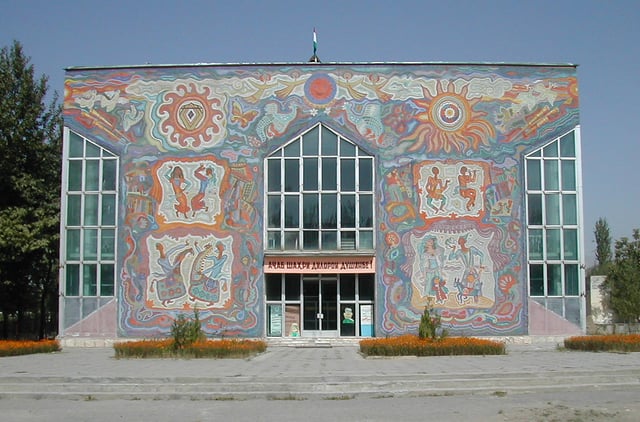Dushanbe
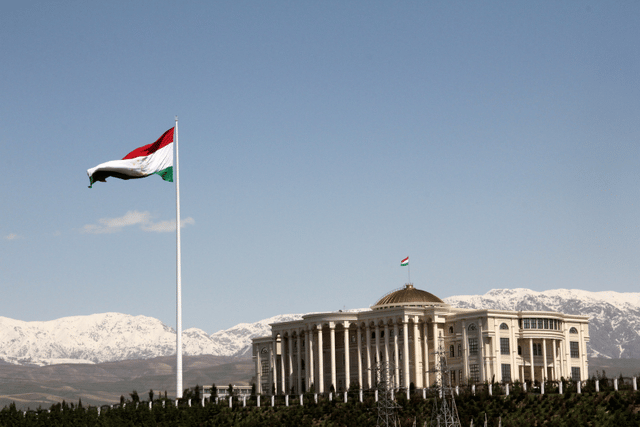
Dushanbe

| Coordinates: | |
| Country | Tajikistan |
|---|---|
| Government | |
| • Mayor | Rustam Emomali |
| Area | |
| • City | 124.6 km2(48.1 sq mi) |
| Elevation | 706 m (2,316 ft) |
| Population | |
| • City | 778,500 |
| • Density | 6,200/km (16,000/sq mi) |
| •Metro | 1,051,200 |
| Time zone | UTC+5(Tajikistan Time) |
| UTC+5(Tajikistan Time) | |
| HDI(2017) | 0.728[2] |
| Website | |
Dushanbe (Tajik: Душанбе, IPA: [duʃæmˈbe]; meaning Monday in Tajik[3][4]) is the capital and largest city of Tajikistan. It was named this way because it grew from a village that originally had a popular market on Mondays. As of 2016, Dushanbe had a population of 802,700.
Historically a small village, Dushanbe was made the capital of the Tajik Autonomous Soviet Socialist Republic in 1924. Until 1929, the city was known in Russian as Dyushambe (Russian: Дюшамбе, Dyushambe), and from 1929 to 1961 as Stalinabad (Tajik: Сталинобод, Stalinobod), which was named after Joseph Stalin.
| Coordinates: | |
| Country | Tajikistan |
|---|---|
| Government | |
| • Mayor | Rustam Emomali |
| Area | |
| • City | 124.6 km2(48.1 sq mi) |
| Elevation | 706 m (2,316 ft) |
| Population | |
| • City | 778,500 |
| • Density | 6,200/km (16,000/sq mi) |
| •Metro | 1,051,200 |
| Time zone | UTC+5(Tajikistan Time) |
| UTC+5(Tajikistan Time) | |
| HDI(2017) | 0.728[2] |
| Website | |
History

Dushanbe Post Office in 1937
Situated at the confluence of two rivers, Varzob and Kofarnihon, Dushanbe is the capital of Tajikistan. Although archaeological remnants dating to the 5th century BC have been discovered in the area, there is little to suggest that Dushanbe was more than a small village until the early 20th century.
It was at the crossroads, where a large bazaar occurred on Mondays, hence the name Dushanbe-Bazar (Tajik: Душанбе Бозор, Dushanbe Bozor)[5] from Dushanbe, which means Monday in the Persian language,[3][4] literally – the second day (du) after Saturday (shambe). In the village, there were more than 500 households and a population of about 8,000 people.
By 1826, the town was called Dushanbe Qurghan (Tajik: Душанбе Қурғон, Dushanbe Qurghon, with the suffix qurƣon from Turkic qurğan, meaning "fortress") Russified as Dyushambe (Дюшамбе). The first map showing Dyushambe was drafted in 1875. At that time, the town was a fortress on a steep bank on the left bank of the Varzob River with 10,000 residents.
In 1920, the last Emir of Bukhara briefly took refuge in Dushambe after being overthrown by the Bolshevik revolution. He fled to Afghanistan after the Red Army conquered the area the next year.[6] At the beginning of 1922, the town was taken by Basmachi troops led Enver Pasha, but on 14 July 1922 again came under the power of the Bolsheviks and was proclaimed the capital of the Tajik Autonomous Soviet Socialist Republic as a part of the Uzbek Soviet Socialist Republic in 1924.
A Tajik Soviet Socialist Republic separate from the Uzbek SSR was created in 1929, and its capital Dyushambe was renamed Stalinabad (Russian: Сталинабад; Tajik: Сталинобод Stalinobod) for Joseph Stalin on 16 October 1929. In the years that followed, the city developed at a rapid pace.[7] Several architects played a major role in the city's construction, among them Peter Vaulin, Peter Kuzmenko and Konstantin Terletsky.
The Soviets transformed the area into a centre for cotton and silk production, and tens of thousands of people relocated to the city.
The population also increased with thousands of Tajiks migrating to Tajikistan following the transfer of Bukhara and Samarkand to the Uzbek SSR as part of national delimitation in Central Asia.[8]
On 10 November 1961, as part of de-Stalinization,[9] Stalinabad was renamed back to Dushanbe, the name it retains to this day.
Severe rioting occurred in February 1990, after it was rumored that the Soviet government planned to relocate tens of thousands of Armenian refugees to Tajikistan. The Dushanbe riots were primarily fueled by concerns about housing shortages for the Tajik population, but they coincided with a wave of nationalist unrest that swept Transcaucasia and other Central Asian states during the twilight of Mikhail Gorbachev's rule.[10] Dushanbe became the capital of an independent Tajikistan in 1991.
In January 2017, Rustam Emomali, current President Emomali Rahmon's son, was appointed Mayor of Dushanbe, a move which is seen by some analysts as a step to reaching the top of the government.[11]
Geography
Climate
Dushanbe features a Mediterranean climate (Köppen: Csa),[12] with strong continental climate influences (Köppen: Dsa).[12] The summers are hot and dry and the winters are chilly, but not very cold. The climate is damper than other Central Asian capitals, with an average annual rainfall over 500 millimetres (20 in) as moist air is funnelled by the surrounding valley during the winter and spring. Winters are not as cold as further north owing to the shielding of the city by mountains from extremely cold air from Siberia. January 2008 was particularly cold, and the temperature dropped to −22 °C (−8 °F).[13]
| Climate data for Dushanbe (1961–1990, extremes 1951–2012) | |||||||||||||
|---|---|---|---|---|---|---|---|---|---|---|---|---|---|
| Month | Jan | Feb | Mar | Apr | May | Jun | Jul | Aug | Sep | Oct | Nov | Dec | Year |
| Record high °C (°F) | 21.6(70.9) | 23.1(73.6) | 30.6(87.1) | 35.6(96.1) | 38.8(101.8) | 43.0(109.4) | 43.3(109.9) | 45.0(113.0) | 40.6(105.1) | 36.8(98.2) | 31.7(89.1) | 24.3(75.7) | 45.0(113.0) |
| Average high °C (°F) | 7.9(46.2) | 10.2(50.4) | 15.2(59.4) | 22.1(71.8) | 27.0(80.6) | 33.1(91.6) | 35.8(96.4) | 34.3(93.7) | 30.7(87.3) | 24.2(75.6) | 17.1(62.8) | 10.8(51.4) | 22.4(72.3) |
| Daily mean °C (°F) | 2.1(35.8) | 3.8(38.8) | 9.2(48.6) | 15.4(59.7) | 20.0(68.0) | 25.3(77.5) | 27.1(80.8) | 24.9(76.8) | 20.1(68.2) | 14.3(57.7) | 8.9(48.0) | 4.8(40.6) | 14.7(58.5) |
| Average low °C (°F) | −2.0(28.4) | −0.2(31.6) | 4.2(39.6) | 9.3(48.7) | 13.0(55.4) | 16.5(61.7) | 17.9(64.2) | 15.9(60.6) | 11.1(52.0) | 6.7(44.1) | 3.5(38.3) | 0.8(33.4) | 8.2(46.8) |
| Record low °C (°F) | −26.6(−15.9) | −17.3(0.9) | −13.4(7.9) | −7.8(18.0) | 1.2(34.2) | 8.4(47.1) | 10.9(51.6) | 8.1(46.6) | 1.9(35.4) | −4.4(24.1) | −13.5(7.7) | −19.5(−3.1) | −26.6(−15.9) |
| Averageprecipitationmm (inches) | 66.3(2.61) | 75.4(2.97) | 107.5(4.23) | 105.0(4.13) | 66.0(2.60) | 5.5(0.22) | 3.2(0.13) | 0.5(0.02) | 3.1(0.12) | 30.6(1.20) | 44.7(1.76) | 59.8(2.35) | 567.6(22.35) |
| Average precipitation days(≥ 1.0 mm) | 8.5 | 9.1 | 13.4 | 9.8 | 7.8 | 1.5 | 0.7 | 0.1 | 0.8 | 3.7 | 5.3 | 8.1 | 68.8 |
| Averagerelative humidity(%) | 69 | 67 | 65 | 63 | 57 | 42 | 41 | 44 | 44 | 56 | 63 | 69 | 57 |
| Mean monthlysunshine hours | 120 | 121 | 156 | 198 | 281 | 337 | 352 | 338 | 289 | 224 | 164 | 119 | 2,699 |
| Source #1:Deutscher Wetterdienst[14] | |||||||||||||
| Source #2: NOAA (sun, 1961–1990) | |||||||||||||
Districts
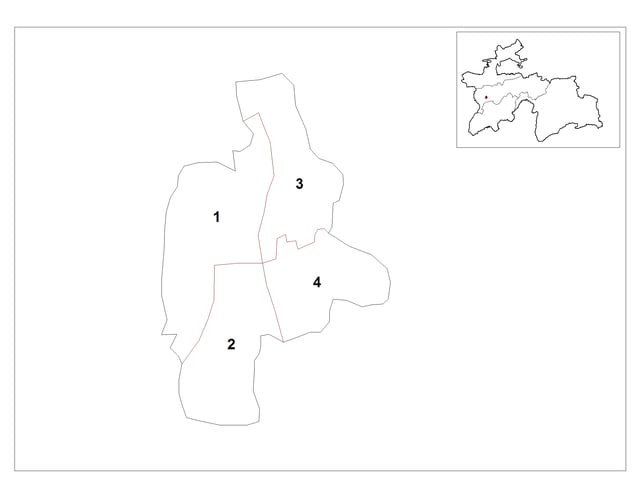
Districts of Dushanbe
Dushanbe is divided into the following districts:
Main sights[16]
Tajikistan National Museum
National Museum of Antiquities
Ismaili Centre
Vahdat Palace
Dushanbe Flagpole—It is the second tallest free-standing flagpole in the world, at a height of 165 metres (541 feet),[17]
Dushanbe Zoo
Rudaki Avenue
Gurminj Museum of Musical Instruments
Demographics
The population of Dushanbe:
in 1987 was about 796,000 and was made up of ethnic Tajiks (75%), Uzbeks (10%), ethnic Russians (3%), and others (12%);
in 2010 was made up of ethnic Tajiks (89.5%), Uzbeks (6.7%), Tatars (0.3%), Turkmens (0.1%), and others (0.7%);[18]
in 2016 was about 802,400 and was made up of ethnic Tajiks (c. 84.4%), Uzbeks (9.1%), Russians (4.1%), and others (2.4%).
Economy and infrastructure
Transport
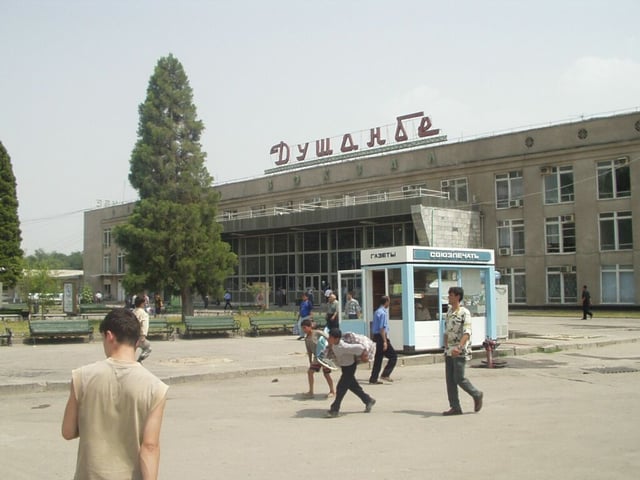
Dushanbe Railway Station
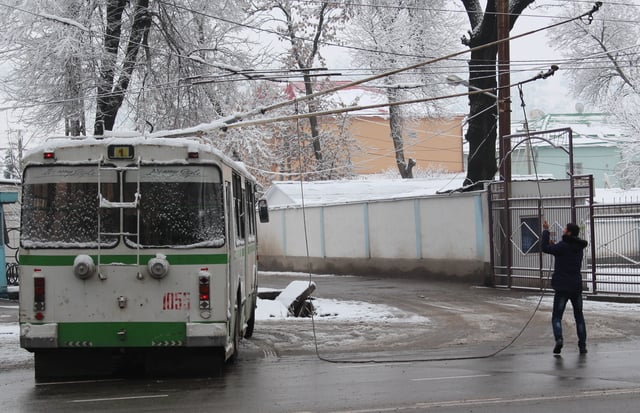
Trolleybus in Dushanbe
The city is served by Dushanbe International Airport which as of April 2015, had regularly scheduled flights to major cities in Russia, Central Asia, as well as Delhi, Dubai, Frankfurt, Istanbul, Kabul, and Ürümqi amongst others. Tajikistan's principal railways are in the southern region and connect Dushanbe with the industrial areas of the Gissar and Vakhsh valleys and with Uzbekistan, Turkmenistan, Kazakhstan and Russia.[25]
The Dushanbe trolleybus system operates public buses in the city. Automobiles are the main form of transportation in the country. The Uzbekistan border is about 50 km away and there is a road that links it to the Uzbek town of Denov. Roads to the north link it to the Sughd Region and from there to parts of Uzbekistan and Kyrgyzstan. The road to the south goes to Afghanistan, accessible via the bridge at Panji Poyon 150 km away.
as of 2014 many highway and tunnel construction projects are underway or have recently been completed.
Major projects include rehabilitation of the Dushanbe – Chanak (Uzbek border), Dushanbe – Kulma (Chinese border), Kurgan-Tube – Nizhny Pyanj (Afghan border) highways and construction of tunnels under the mountain passes of Anzob, Shakhristan, Shar-Shar[26] and Chormazak.[27]
Education
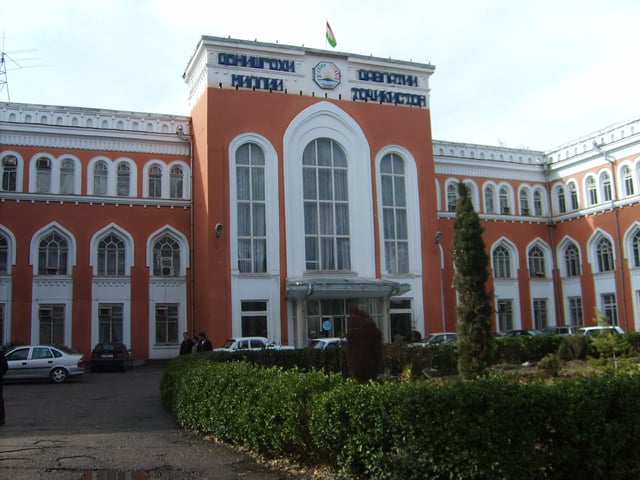
Tajik State National University.
A number of educational facilities are based in Dushanbe:
Tajik National University
Agricultural University of Tajikistan
Tajik State Medical University
Tajikistan State University of Law, Business, & Politics
Russian-Tajik Slavonic University
Dushanbe International School
International relations
Twin towns – Sister cities
Notable people
Dilshod Nazarov (born 1982), hammer thrower
See also
Opera Orchestra of Dushanbe
School for Deaf and Mute (Dushanbe)
Dushanbe Synagogue
Dushanbe Tea House, Boulder, Colorado
List of cities in Tajikistan
